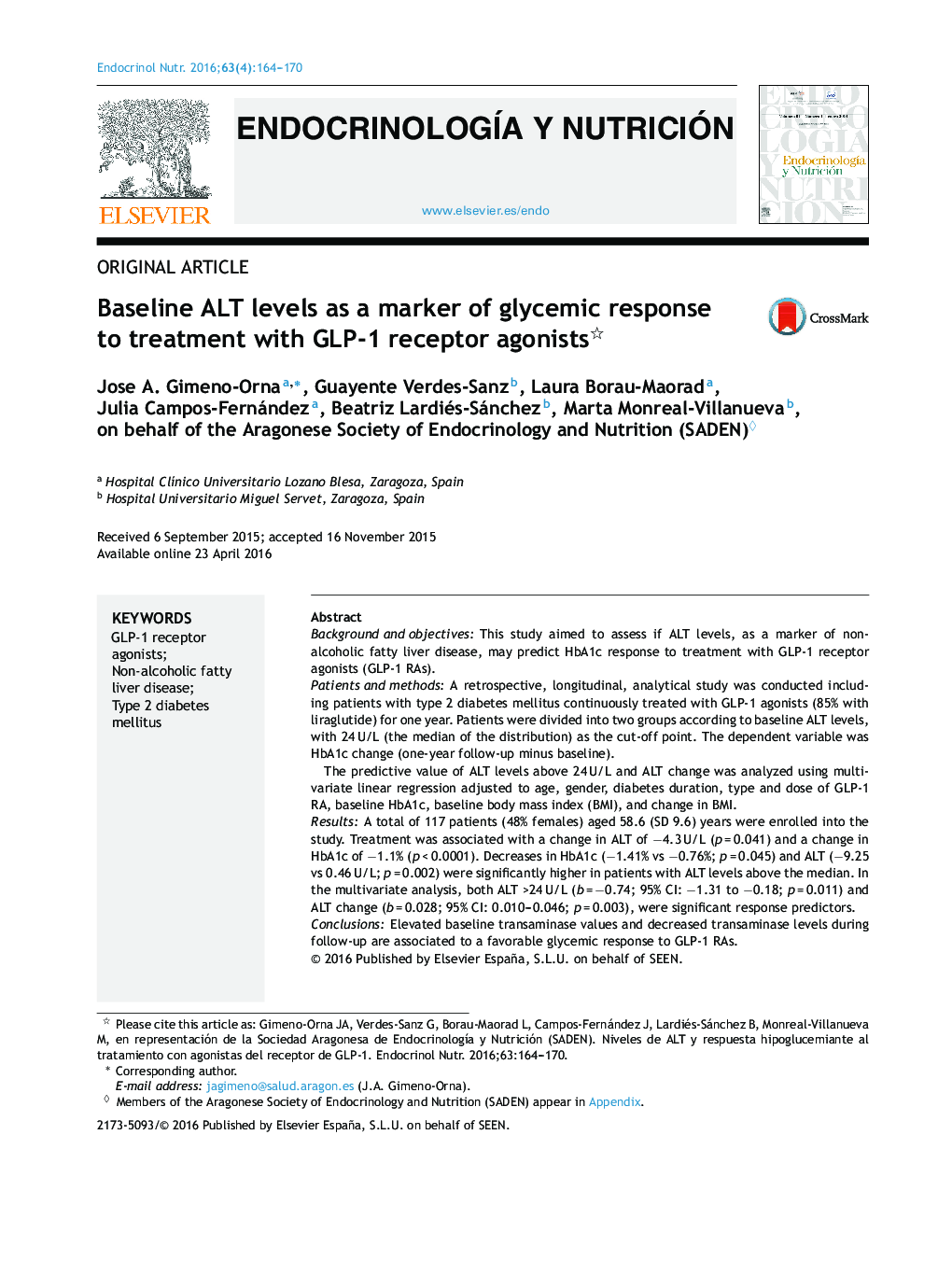| کد مقاله | کد نشریه | سال انتشار | مقاله انگلیسی | نسخه تمام متن |
|---|---|---|---|---|
| 3266806 | 1207942 | 2016 | 7 صفحه PDF | دانلود رایگان |
Background and objectivesThis study aimed to assess if ALT levels, as a marker of non-alcoholic fatty liver disease, may predict HbA1c response to treatment with GLP-1 receptor agonists (GLP-1 RAs).Patients and methodsA retrospective, longitudinal, analytical study was conducted including patients with type 2 diabetes mellitus continuously treated with GLP-1 agonists (85% with liraglutide) for one year. Patients were divided into two groups according to baseline ALT levels, with 24 U/L (the median of the distribution) as the cut-off point. The dependent variable was HbA1c change (one-year follow-up minus baseline).The predictive value of ALT levels above 24 U/L and ALT change was analyzed using multivariate linear regression adjusted to age, gender, diabetes duration, type and dose of GLP-1 RA, baseline HbA1c, baseline body mass index (BMI), and change in BMI.ResultsA total of 117 patients (48% females) aged 58.6 (SD 9.6) years were enrolled into the study. Treatment was associated with a change in ALT of −4.3 U/L (p = 0.041) and a change in HbA1c of −1.1% (p < 0.0001). Decreases in HbA1c (−1.41% vs −0.76%; p = 0.045) and ALT (−9.25 vs 0.46 U/L; p = 0.002) were significantly higher in patients with ALT levels above the median. In the multivariate analysis, both ALT >24 U/L (b = −0.74; 95% CI: −1.31 to −0.18; p = 0.011) and ALT change (b = 0.028; 95% CI: 0.010–0.046; p = 0.003), were significant response predictors.ConclusionsElevated baseline transaminase values and decreased transaminase levels during follow-up are associated to a favorable glycemic response to GLP-1 RAs.
ResumenAntecedentes y objetivoEvaluar si los niveles de ALT, como marcador de esteatosis hepática no alcohólica, pueden determinar la respuesta hipoglucemiante al tratamiento con agonistas del receptor GLP-1 (AR-GLP1).Pacientes y métodosEstudio analítico longitudinal retrospectivo. Se incluyeron pacientes con diabetes tipo 2 (DM2) tratados sin interrupción con AR-GLP1 (85% liraglutida) durante un año. Se clasificó a los pacientes en 2 grupos según niveles iniciales de ALT, con punto de corte en la mediana (24 U/l). La variable dependiente fue el cambio (final-inicial) de HbA1c.El valor predictivo de niveles de ALT > 24 U/l y del cambio en ALT fue analizado con regresión lineal multivariante ajustada para edad, género, evolución de DM2, tipo y dosis de AR-GLP1, niveles iniciales de HbA1c, índice de masa corporal (IMC) y cambio de IMC.ResultadosSe incluyeron 117 pacientes (48% mujeres) con edad media de 58,6 (DE 9,6) años. El tratamiento estuvo asociado con un cambio en ALT de −4,3 U/l (p = 0,041) y un cambio en HbA1c de −1,1% (p < 0,0001). Tanto el descenso de HbA1c (−1,41% vs −0,76%; p = 0,045) como el de ALT (−9,25 vs 0,46 U/l; p = 0,002) fueron significativamente más marcados en pacientes con ALT por encima de la mediana. En análisis multivariante tanto niveles de ALT > 24 U/l (b = −0,74; IC 95%: −1,31 a −0,18; p = 0,011) como el cambio en ALT (b = 0,028; IC 95%: 0,010 a 0,046; p = 0,003) fueron factores predictivos de respuesta.ConclusionesNiveles elevados de transaminasas y su descenso se asocian a una respuesta hipoglucemiante favorable a AR-GLP1.
Journal: Endocrinología y Nutrición (English Edition) - Volume 63, Issue 4, April 2016, Pages 164–170
